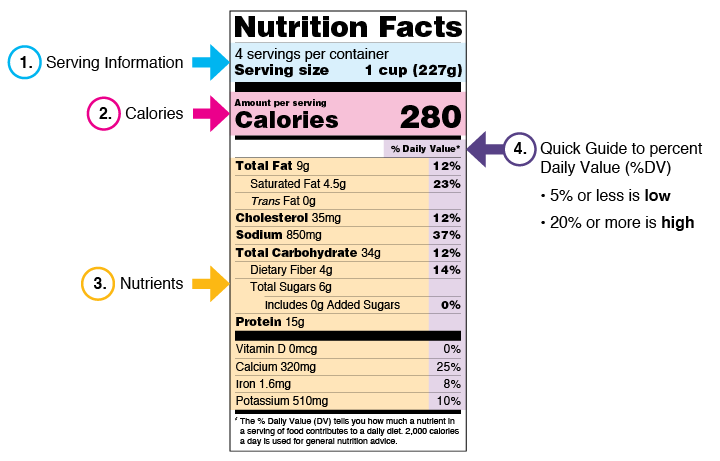Nutrition Basics: Portion Size
Nutrition Basics: Portion Size
By: Jon Collette (Prototype Nutrition Coach)

In part 4 of our nutrition series, we will be going in-depth about portion sizes to help you look and feel your best!
Portion Size:
A portion size is defined as a set amount of food that you are going to consume for an eating event. An eating event could be breakfast, lunch, dinner, a snack… even brunch!
Now I do have to say, to get the most accurate assessment of what your portion size for each event should look like, you would need to know how many TOTAL CALORIES your body needs on a daily basis.
In general, though, we all tend to have more food than we think we are eating.
For example, have you looked at a food label? The food label gives you a breakdown of the serving size, the calories, and the nutrients in the food you are going to eat. If you look at the image below, you can see what I’m talking about!
Take a look at the very bottom. The FDA gives a general recommended daily value (DV) of how much food we should be consuming. That number is 2000 calories AND it’s what the percentages on the Nutrition Facts label are based on.
One of the biggest things that I see when working with clients is helping them gain an understanding of the serving information on this label to help them make more accurate portion sizes. For this particular food, a serving size is 1 cup. I would guess that this food is a “high protein” cereal, so we might pour ourselves a bowl of cereal and think we are eating 280 calories. Did you know that you can probably fit 2-3 cups in your cereal bowl?! That’s more like 550-850 calories, not 280.

Coach Note: When we talk about portion size today, it goes without saying that not everyone should be eating 2000 calories. Everyone needs a prescription that is specific to them, there is no “one size fits all” approach. If you need help, we are here for you!
I know I got you excited about the cereal, but before we start talking more about portion sizes I want to talk about structuring our meals with our key nutrients. To recap from my previous post on this topic, here are some of the benefits of these nutrients which make up the majority of our daily food intake.
Key Nutrients:
Simply put, they are the major nutrients you put in your body that give us ENERGY or SUPPORT CONVERTING ENERGY. They are your:
-
Proteins
-
Carbohydrates
-
Fats
-
and Micro-nutrients (vitamins & minerals)
The first 3, (Protein, carbohydrates, and fats) are what are called your macronutrients . These contain the calories that give us energy (alcohol does as well, but that’s beyond the scope of this!). They are also responsible for adding additional lbs to the scale if taken in excess of what you burn off. But we can talk about that another time!
What is Protein?
-
They are the building blocks of our tissues (muscle, bone, organs, muscle tissue, brain, skin hair, and nails) and everything in our body needs protein to grow and repair.
-
Keeps us healthy, strong increases recovery from exercise-induced stress.
-
Supports growth & development.
-
Contains 4 calories per gram (so 20g of protein=80 calories)
*Fun fact: Protein requires the most amount of energy (calories) for your body to break it down. The breakdown, processing, and storing of food in your body is called the thermic effect of food (TEF). TEF accounts for 5-15% of all the calories you burn per day (based on how much and what you eat). So basically, the more protein you take in, the more calories you will burn just to process and break it down.
What are Carbohydrates?
-
The main fuel source for our body and brain.
-
The quickest energy source that supports exercise.
-
Fiber (a type of carbohydrate the body can’t digest. Also soluble & insoluble) have benefits on gut health, cardiovascular health and helps support stable blood sugar levels.
-
Athletes training at a high level should have higher carb intakes than most sedentary individuals for optimal performance.
-
Like protein, they contain 4 calories per gram (so 20g of carbohydrates=80 calories)
*Fun Fact: Carbs are not the independent source of weight gain AND not all carbs are equal BUT with a balanced nutrition plan, you can fit just about any kind of carb source into your daily diet.
What is fat?
- Gives you energy and supports cell growth.
-
Supports joint health (anti-inflammatory fats like omega 3).
-
Enhances Cognitive function.
-
Allows the absorption of fat-soluble vitamins (A,D,E,K).
-
Contains 9 calories per gram (so 20g of fat=180 calories).
*Fun Fact: 1lb of fat=3,500 calories. That is how much energy is in 1lb of fat. It also means that it will take an excess of 3,500 calories to lose a pound of fat.
Now that we have reviewed our Key Nutrients, there are a few factors we need to keep in mind before deciding what our daily food portion will be:
-
What are your #Goals? (weight loss, gain weight, maintain weight, performance-driven)
If your goals are weight loss, chances are we need to be in a caloric deficit. If you want to pack on weight and muscle mass, you may need to be in a caloric surplus.
-
What is your Physical activity level like? (how much movement do you get a day?)
Even though physical activity and exercise account for roughly 10% of the total daily energy expenditure (average, some people are less some are more), it’s a factor we need to consider when sorting through how much you need to eat.
-
What Time of day will you be eating? (especially around exercise)
When talking portion size, I wouldn’t advise having a 1500 calorie meal before you run 10 miles. Just saying… But fasted cardio in the early morning might not require you to have any food! So this depends and needs to be accounted for.
-
What is your current body weight? What’s your gender? How old are you? (these are SUPER important!)
There are biological and physiological factors that we need to note that will play into your total caloric needs. As we get older and as our hormonal levels change, what we eat, and how much is important. In addition, males typically can eat more food than females due to having greater levels of muscle mass. The more muscle you have, the more energy you can burn, so the more food you can consume. Again, this stuff is important! There is no one size fits all approach!
What should your portion sizes look like and what should they consist of?
- Try to keep your meals consistent. You should aim to have a serving of each key nutrient that fills your plate.
- A general way to estimate portion sizes would be using your hand as a measuring tool. The best practice and more precise would be to use a food scale. These are pretty cheap but using it is the hard part! You can find one here if you need one!
If a food scale is a little too much, use your hand:
- 1 serving of protein = palm size
- 1 serving of carbohydrates = 1 cupped handful
- 1 serving of fats = 2 thumbs worth
- Portion sizes will vary depending on what type of activity you’re doing.
- A track athlete will need more carbohydrates (for example) than a weightlifter, and a weightlifter might need more protein as well as more frequent protein feeding.
For the general population (all of us!), the serving size template can be a good approach. Again, we will need to get more specific to figure out how many calories you need but using some of these strategies below can also help determine what’s a good portion size for you.
-
Eat slow and mindfully
If you’re not counting your macros, this strategy allows you to determine if you need to eat the whole serving or if you should add more. Sometimes we eat so fast we don’t realize when we are satisfied. It’s like going to an “all you can eat” buffet when you’re starving and packing your plate. Do you really need all that food?
-
Have more carbohydrates on days of high amounts of activity
Carbohydrates are your body’s main energy source, especially when doing high-intensity exercise. If you did a lot of conditioning, interval sprints, or just feel better with higher amounts of carbs, don’t be afraid, eat them! Try to eat more whole food choices to keep calories controlled (oats or rice vs candy and chips) and to keep your blood sugar at bay. Think higher fiber foods! This will also help you feel fuller, faster.
-
Ask yourself: How will this make me feel?
If your portion is so small or so big that you know right away how you’re going to feel adjust it to start! You can always add more food if you’re really hungry. It’s harder to not finish what’s on your plate when you put it there, no one wants to be wasteful, right?!
Stay tuned next week where we talk about the benefits of proper hydration!
The post Nutrition Basics: Portion Size appeared first on Prototype Training Systems.
Previous Blogs


Climb to New Heights
Prototype Training Systems is more than a gym - it is a lifestyle. Join us today!


